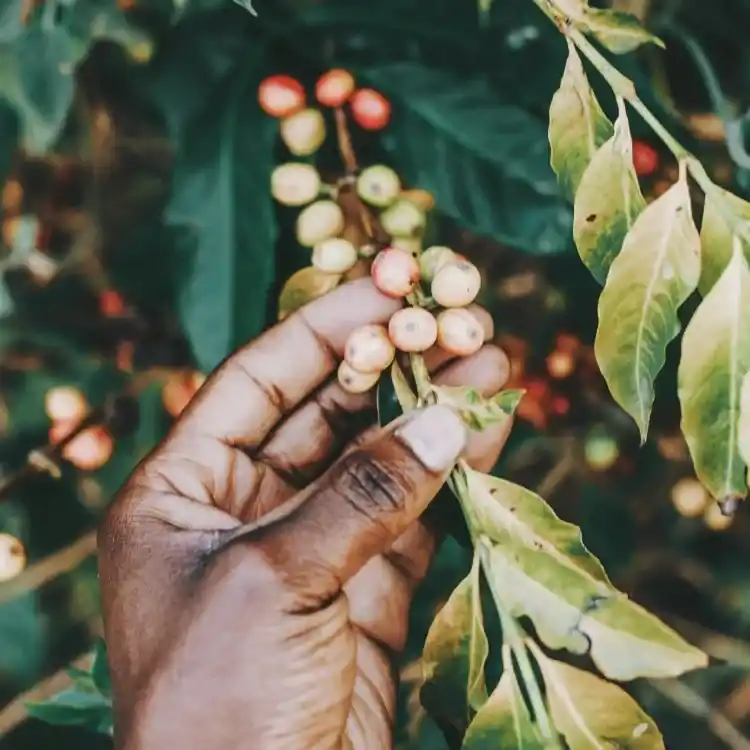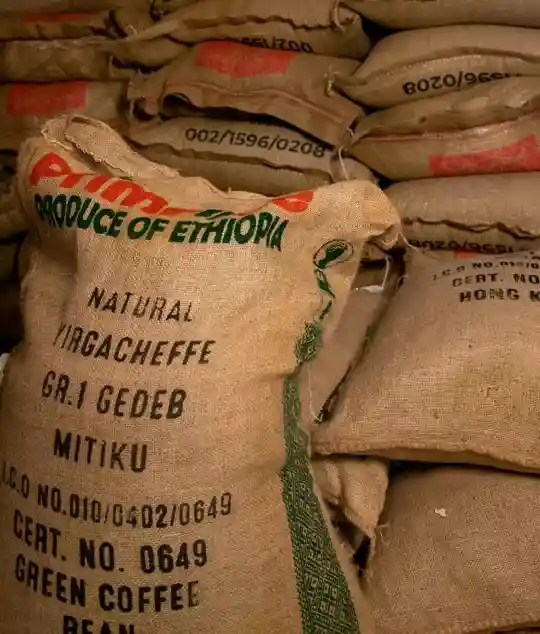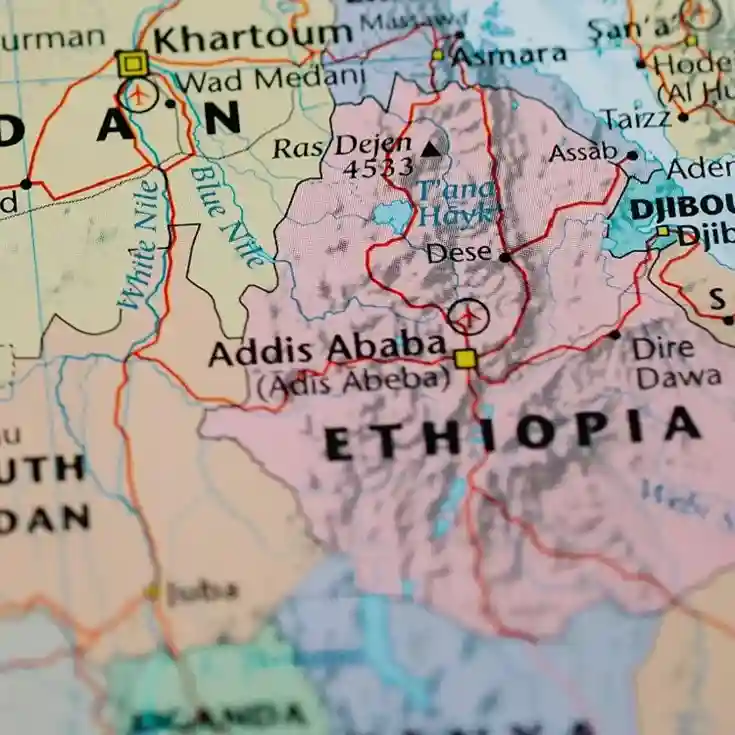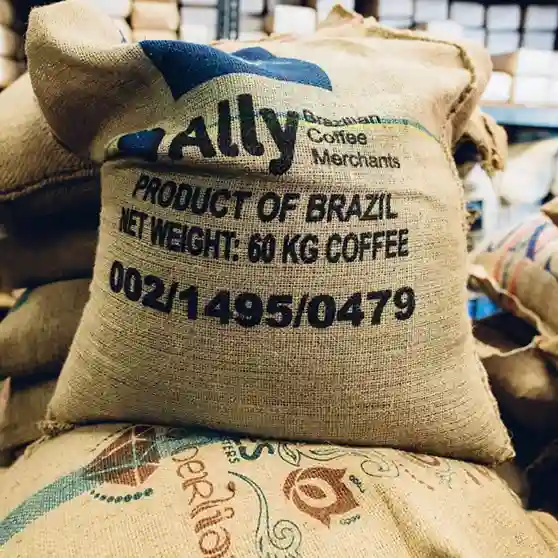Historical origins and traditions of Ethiopia
Ethiopia is the birthplace of coffee. According to legend, a shepherd named Kaldi noticed that his goats became extremely energetic after eating berries from a wild bush.
Coffee has become the heart of local culture, a way of life, and a form of communication. A traditional coffee ceremony is a slow, almost sacred ritual that brings family and guests together. Coffee is served three times in Ethiopia, and each cup has its own meaning.

Natural conditions for growing coffee
Nature has created ideal conditions for growing coffee in Ethiopia. High mountainous areas with a temperate tropical climate, generous rains and mild sunshine form a unique terroir. The altitude, from 1500 to 2200 meters above sea level, slows down the ripening of berries, giving the grain a more complex flavor and bright acidity. Fertile volcanic soils, rich in minerals, nourish the coffee plantations, creating exceptional flavor profiles. Two rainy seasons ensure a consistent harvest.
Geography of coffee production
Altitude, microclimate and processing methods shape the unique character of each grain. The map of Ethiopian production is strikingly diverse. Among the most famous coffee-growing regions:
Syrah. Grains from this area have bright acidity and floral notes.
Guji. Here, grapes with a clean profile and fruity depth ripen.
The legendary Harar. The grains have wine and spicy flavors.
The Jimma, Limu, Benchi-Madi, western and southwestern Ethiopia regions are known for their rich, chocolate-fruity, spicy flavors.
The variety of Ethiopian coffee varieties and types
Ethiopia is home to the largest genetic diversity of coffee trees in the world. The country’s natural forests are home to many autochthonous, or indigenous, varieties of
This wealth is the basis for the JARC (Jimma Agricultural Research Center), a research center that breeds new varieties. Thanks to their efforts, hybrids have been created that can better withstand imperfect environments, have higher yields, and are resistant to diseases and pests.
In addition to breeding achievements, regional varieties with unique flavor profiles deserve special attention. For example,

Technologies for growing and caring for plantations
In Ethiopia, coffee production combines traditional cultivation with modern technology. The coffee trees are planted by hand on terraces or slopes, taking into account the optimal distance to ensure access to light and air. Many farms practice mixed cultivation: coffee bushes grow in the shade of trees, which reproduces the conditions of the natural environment.
Care systems include regular pruning of trees to stimulate fruiting, mulching of the soil to preserve moisture, and the application of organic fertilizers. As the climate provides sufficient rainfall, irrigation is hardly ever practiced on the plantations.
Disease and pest control is usually carried out using agroecological methods: using biological products, natural enemies of pests, and careful selection of resistant varieties.
Particular attention is paid to organic farming: farmers avoid chemicals, maintain soil fertility, and preserve biodiversity.
The sustainable approach to cultivation not only preserves the ecosystem but also improves the quality of the beans, making Ethiopian coffee even more valuable on the global market.
Methods of harvesting and processing coffee berries
Coffee berries are traditionally harvested by hand. This method allows us to carefully select only ripe fruits. Manual harvesting is a labor-intensive process, but it allows us to preserve the rich flavor potential of the beans.
The processing method has a significant impact on the taste of coffee and is chosen based on the variety, climate and desired flavor profile.
The dry method is the oldest: the berries are dried in the sun, whole, with the pulp. This process gives the coffee a rich tropical fruit flavor with wine or berry notes.
The wet method involves removing the pulp before fermentation and washing the grain, which results in a clean, bright flavor profile with a distinct acidity.
There is also a semi-wet method: part of the pulp is left on the grain during drying, which achieves a balance between sweetness and acidity.
Quality assessment and grading system
The quality and grade of coffee significantly affect its price and demand on the global market.
Ethiopia has a clear quality assessment system that takes into account both physical and sensory characteristics of the grain. The main criteria are bean size and uniformity, defects, aroma, acidity, body, aftertaste, and overall cup impression.
Beans are classified by grades, from 1 to 9, where Grade 1 is the highest and meets international standards for specialty coffee, with a minimum of defects and a pronounced flavor profile. Grades below 2 are commercial coffees with more defects.
To determine the quality, we use laboratory methods, including capping, professional tasting with an assessment of each parameter on a 100-point scale. All samples are tested in certified laboratories under the supervision of the National Coffee Institute of Ethiopia.
Taste characteristics of Ethiopian coffee
Ethiopian coffee is known around the world for its unique flavor profiles, which largely depend on the region of cultivation, variety, altitude and processing method. For example, beans from Jirgacheffe have bright floral aromas and lemon acidity, while Sidamo is characterized by berry and tropical notes. In Harrar, the flavor can have wine, spicy or even chocolate tones.
Most coffees from Ethiopia are characterized by pronounced fruitiness, floral aroma, medium to light body and high acidity, which gives the drinks brightness and freshness. This set of characteristics is highly valued in the specialty segment.
The roasting method also affects the flavor development. Light or medium roasting preserves the natural notes inherent in each variety, while dark roasting smooths out the acidity and emphasizes the bitter and caramel notes.
This complex palette makes Ethiopian coffee unique and recognizable among connoisseurs.

The economic importance of the Ethiopian coffee industry
Ethiopia’s coffee industry plays a key role in the economy. The country is one of the largest producers of Arabica in the world. It accounts for more than 30% of export earnings and provides an important part of foreign exchange reserves. The annual production is more than 7 million bags of coffee, of which a significant portion is exported to Europe, the United States and the Middle East.
Domestic consumption is also high. Approximately 50% of the harvest remains in the country.
The coffee industry employs more than 15 million Ethiopians, mostly in rural areas. They include farmers, seasonal workers, exporters, processors, and retailers.
The socio-economic situation of a country largely depends on the stability of the sector’s production. Supporting small farms and developing sustainable practices is crucial for the future of the economy.
Current challenges and development prospects
One of the most pressing issues affecting the quality and volume of production is climate change. Rising temperatures, erratic precipitation, and the spread of diseases are reducing coffee yields.
Insufficient development of transportation infrastructure and logistics chains complicates exports and increases production costs. Farmers work with outdated equipment and lack access to modern processing technologies, which reduces the competitiveness of their products.
Investments in infrastructure, access to education and modern agricultural technologies, support for cooperatives, and improving the welfare of farmers can all help ensure the industry’s sustainable development.
Ethiopian products have great potential, and overcoming the challenges will be the key to their successful future in the global market.
Market trends and global outlook
The growing demand for specialty coffee opens up new opportunities for exporting quality varieties with a unique flavor profile. More and more consumers value authenticity and transparency, which stimulates the development of direct trade with farmers. This model allows farmers to receive a fair price and provides buyers with access to high-quality products.
Global trends are focused on sustainable development, environmental friendliness, and social responsibility, which encourages Ethiopian manufacturers to innovate and improve working conditions.
Coffee from Ethiopia, with its variety of varieties and flavor profiles, has every chance to strengthen its position as a leader in the premium segment of the global market.
Practical advice for consumers
Choose freshly roasted Grade 1-2 beans with a clear indication of the variety, region, country of origin and processing.
Different varieties of Ethiopian coffee have their own brewing characteristics. For example, for varieties with bright acidity and floral notes, such as Ergacheffe, the filtered method or pour-over is better suited. Varieties with a rich body are ideal for espresso or French press.
Traditional buna is a drink made from fresh grains over an open fire in a jezve.
Store the grains in an airtight container, away from light, moisture, and odors.





